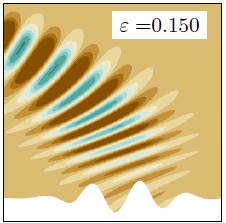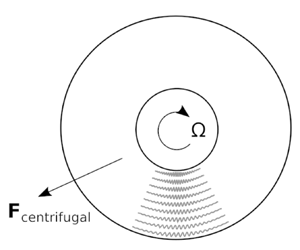Three-Dimensional Multiscale Dynamics of Gravity Waves (3DMSD)

PIs
Prof. Dr. Ulrich Achatz, Goethe Universität Frankfurt, Frankfurt/Main
Dr. Gergely Bölöni, Goethe Universität Frankfurt, Frankfurt/Main
Prof. Dr. Rupert Klein, Freie Universität Berlin
Postdocs and PhD students:
Dr. Mark Schlutow, FUB
Dr. Georg Sebastian Völker, GUF
Dr. Junhong Wei, GUF
Summary: In this project in the research unit the multi-scale asymptotic dynamics of gravity-wave (GW) propagation is addressed, based on a nonlinear WKB theory of the principal investigators and their methodological developments for the practical implementation of WKB equations. Theory and method will be extended by the interaction between resolved and non-resolved GWs, and a reconsideration of the mutual interaction between GWs and geostrophic modes, and with the synoptic-scale flow. This will be supplemented by an improved description of GW dissipation, and, in interaction with the FOR project GW-ICE, by suitable scale-dependent models for gravity wave tropopause-interactions. The outcome will be a general theory and numerical method for the prediction of GW propagation, wave-mean-flow interaction, and dissipation. The results will be tested against idealized large-eddy simulations. This will feed directly, via a prognostic model for subgrid-scale GWs (MS-GWaM), into the global GW permitting model (UA-ICON) developed within the FOR project GWING. This is coupled to the source descriptions delivered by the Research unit projects SV and SI. In UA-ICON/MS-GWaM the waves will affect the large-scale flow. The option to use it in diagnostic mode, without feedback on the resolved flow, is intended as well.
Results:
The Publications show most detailed the research going on within the project. The abstracts of the most recent:
- Waves in the gas centrifuge: Asymptotic theory and similarities with the atmosphere: Rodal, Marie, & Schlutow, Mark (2021). Journal of Fluid Mechanics, 928, A17. https://doi.org/10.1017/jfm.2021.811
 We study the stratified gas in a rapidly rotating centrifuge as a model for the Earth's atmosphere. Based on methods of perturbation theory, it is shown that in certain regimes, internal waves in the gas centrifuge have the same dispersion relation to leading order as their atmospheric siblings. Assuming an air filled centrifuge with a radius of around 50 cm, the optimal rotational frequency for realistic atmosphere-like waves is around 10 000 revolutions per minute. Using gases of lower heat capacities at constant pressure, such as xenon, the rotational frequencies can be even halved to obtain the same results. Similar to the atmosphere, it is feasible in the gas centrifuge to generate a clear scale separation of wave frequencies and therefore phase speeds between acoustic waves and internal waves. In addition to the centrifugal force, the Coriolis force acts in the same plane. However, its influence on axially homogeneous internal waves appears only as a higher-order correction. We conclude that the gas centrifuge provides an unprecedented opportunity to investigate atmospheric internal waves experimentally with a compressible working fluid.
We study the stratified gas in a rapidly rotating centrifuge as a model for the Earth's atmosphere. Based on methods of perturbation theory, it is shown that in certain regimes, internal waves in the gas centrifuge have the same dispersion relation to leading order as their atmospheric siblings. Assuming an air filled centrifuge with a radius of around 50 cm, the optimal rotational frequency for realistic atmosphere-like waves is around 10 000 revolutions per minute. Using gases of lower heat capacities at constant pressure, such as xenon, the rotational frequencies can be even halved to obtain the same results. Similar to the atmosphere, it is feasible in the gas centrifuge to generate a clear scale separation of wave frequencies and therefore phase speeds between acoustic waves and internal waves. In addition to the centrifugal force, the Coriolis force acts in the same plane. However, its influence on axially homogeneous internal waves appears only as a higher-order correction. We conclude that the gas centrifuge provides an unprecedented opportunity to investigate atmospheric internal waves experimentally with a compressible working fluid.
- On strongly nonlinear gravity waves in a vertically sheared atmosphere: Schlutow, Mark and Voelker, Georg S.. "" Mathematics of Climate and Weather Forecasting, vol. 6, no. 1, 2020, pp. 63-74. https://doi.org/10.1515/mcwf-2020-0103
We investigate strongly nonlinear stationary gravity waves which experience refraction due to a thinvertical shear layer of horizontal background wind. The velocity amplitude of the waves is of the same orderof magnitude as the background ow and hence the self-induced mean ow alters the modulation propertiesto leading order. In this theoretical study, we show that the stability of such a refracted wave depends on theclassical modulation stability criterion for each individual layer, above and below the shearing. Additionally,the stability is conditioned by novel instability criteria providing bounds on the mean- ow horizontal windand the amplitude of the wave. A necessary condition for instability is that the mean- ow horizontal wind inthe upper layer is stronger than the wind in the lower layer. - Toward Transient Subgrid-Scale Gravity Wave Representation in Atmospheric Models. Part I: Propagation Model Including Nondissipative Wave–Mean-Flow Interactions; Bölöni, G., Kim, Y., Borchert, S., & Achatz, U. (2021)., https://doi.org/10.1175/JAS-D-20-0065.1
Current gravity wave (GW) parameterization (GWP) schemes are using the steady-state assumption, in which an instantaneous balance between GWs and mean flow is postulated, thereby neglecting transient, nondissipative interactions between the GW field and the resolved flow. These schemes rely exclusively on wave dissipation, by GW breaking or near critical layers, as a mechanism leading to forcing of the mean flow. In a transient GWP, without the steady-state assumption, nondissipative wave–mean-flow interactions are enabled as an additional mechanism. Idealized studies have shown that this is potentially important, and therefore the transient GWP Multiscale Gravity Wave Model (MS-GWaM) has been implemented into a state-of-the-art weather and climate model. In this implementation, MS-GWaM leads to a zonal-mean circulation that agrees well with observations and increases GW momentum-flux intermittency as compared with steady-state GWPs, bringing it into better agreement with superpressure balloon observations. Transient effects taken into account by MS-GWaM are shown to make a difference even on monthly time scales: in comparison with steady-state GWPs momentum fluxes in the lower stratosphere are increased and the amount of missing drag at Southern Hemispheric high latitudes is decreased to a modest but nonnegligible extent. An analysis of the contribution of different wavelengths to the GW signal in MS-GWaM suggests that small-scale GWs play an important role down to horizontal and vertical wavelengths of 50 km (or even smaller) and 200 m, respectively. - An Application of WKBJ Theory for Triad Interactions of Internal Gravity Waves in Varying Background Flows: Völker, G.S., Akylas T.R. and U. Achatz, 2021 DOI: 10.1002/qj.3962
Motivated by the question of whether and how wave–wave interactions should be implemented into atmospheric gravity‐wave parametrizations, the modulation of triadic gravity‐wave interactions by a slowly varying and vertically sheared mean flow is considered for a non‐rotating Boussinesq fluid with constant stratification. An analysis using a multiple‐scale WKBJ (Wentzel–Kramers–Brillouin–Jeffreys) expansion identifies two distinct scaling regimes, a linear off‐resonance regime, and a nonlinear near‐resonance regime. Simplifying the near‐resonance interaction equations allows for the construction of a parametrization for the triadic energy exchange which has been implemented into a one‐dimensional WKBJ ray‐tracing code. Theory and numerical implementation are validated for test cases where two wave trains generate a third wave train while spectrally passing through resonance. In various settings, of interacting vertical wavenumbers, mean‐flow shear, and initial wave amplitudes, the WKBJ simulations are generally in good agreement with wave‐resolving simulations. Both stronger mean‐flow shear and smaller wave amplitudes suppress the energy exchange among a resonantly interacting triad. Experiments with mean‐flow shear as strong as in the vicinity of atmospheric jets suggest that internal gravity‐wave dynamics are dominated in such regions by wave modulation. However, triadic gravity‐wave interactions are likely to be relevant in weakly sheared regions of the atmosphere. -
Generalized modulation theory for strongly nonlinear gravity waves in a compressible atmosphere: Schlutow, Mark and Wahlén, Erik. https://doi.org/10.1515/mcwf-2020-0105
This study investigates strongly nonlinear gravity waves in the compressible atmosphere from theEarth’s surface to the deep atmosphere. These waves are effectively described by Grimshaw’s dissipative mod-ulation equations which provide the basis for finding stationary solutions such as mountain lee waves andtesting their stability in an analytic fashion. Assuming energetically consistent boundary and far-field con-ditions, that is no energy flux through the surface, free-slip boundary, and finite total energy, general wavesolutions are derived and illustrated in terms of realistic background fields. These assumptions also implythat the wave-Reynolds number must become less than unity above a certain height. The modulational sta-bility of admissible, both non-hydrostatic and hydrostatic, waves is examined. It turns out that, when ac-counting for the self-induced mean flow, the wave-Froude number has a resonance condition. If it becomes1/√2,then the wave destabilizes due to perturbations from the essential spectrum of the linearized modula-tion equations. However, if the horizontal wavelength is large enough, waves overturn before they can reachthe modulational stability condition. -
On strongly nonlinear gravity waves in a vertically sheared atmosphere: Schlutow, Mark and Voelker, Georg S. https://doi.org/10.1515/mcwf-2020-0103
We investigate strongly nonlinear stationary gravity waves which experience refraction due to a thinvertical shear layer of horizontal background wind. The velocity amplitude of the waves is of the same orderof magnitude as the background ow and hence the self-induced mean ow alters the modulation propertiesto leading order. In this theoretical study, we show that the stability of such a refracted wave depends on theclassical modulation stability criterion for each individual layer, above and below the shearing. Additionally,the stability is conditioned by novel instability criteria providing bounds on the mean- ow horizontal windand the amplitude of the wave. A necessary condition for instability is that the mean- ow horizontal wind inthe upper layer is stronger than the wind in the lower layer.

